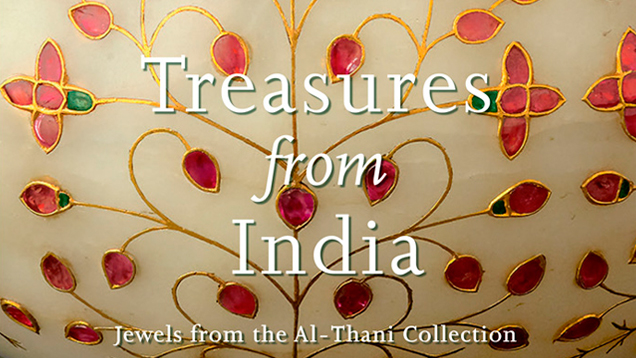Books: Treasures from India: Jewels from the Al-Thani Collection
November 13, 2015

India, home to one of the world’s oldest civilizations, is known for its glamorous jewelry and ornamental objects reflecting thousands of years of rich culture. The substantial evidence preserved through sculptures and ancient texts supports the premise that jewelry and objets d’art have long been an integral part of Indian culture. A rare collection of these artifacts was on view at the Metropolitan Museum of Art in New York between November 2014 and January 2015. The exhibition consisted of sixty-three objects dating from the Mughal Period (1526-1858) to present day, some of which were created by luxury brands such as Cartier and JAR. Treasures from India: Jewels from the Al-Thani Collection by Navina Najat Haidar and Courtney Ann Stewart, also the curators of the exhibition, provides insight into this dazzling array of Indian jewelry and its evolution over time.
The lavishness of Indian jewelry is well known, yet seeing exquisite examples in a single, private collection is a rare occasion. Aspects of India’s jewelry culture reflect a traditional use of precious ornaments as both symbols of social status and as talismans. It would be an understatement to refer to this volume as an “exhibition catalogue.” The authors guide the reader through an intriguing narrative of Indian jewelry, often making connections to major historical events. For example, Anna Tonelli’s watercolor of Tipu Sultan’s throne, completed in 1793 and dismantled after the sultan’s death in 1799, clearly depicts the eight tiger’s head finials around the perimeter of the throne’s base. One of these finials is in the collection. Following the general review of the collection of more than 250 objects and their historical and cultural background, a discussion of the iconic pieces comprising the exhibition is presented in detail with attention given to their origin, style, and functionality.
The artistry and use of valuable materials, including gold, jade, ruby, emerald and pearl demonstrate the prominence of Mughal civilization in the collection’s older pieces. Some pieces, such as jeweled flasks and large turban ornaments, are of no ordinary size. They certainly reflect the important status of Mughal rulers. Skillfully carved, embellished and crafted pieces such as daggers, boxes, and body ornaments are presented to the reader with good photography. It is also noteworthy to mention that for almost every piece, the authors include a historical image, such as an old drawing or a painting, to help explain its utility or functionality. One notable piece is the Patiala ruby choker, seen in a 1931 photo of the Maharaja Bhupindra Singh of Patiala with his family members. In the photo, the choker is worn by one of his wives. The choker was one of many pieces that the Maharaja commissioned Cartier to model on older pieces from his treasury.
As many gemologists may be aware, despite the details given in the history or the style of such collections, the gemstones are generally ignored when it comes to elaborating their identity. Fortunately, it is refreshing to read detailed description of the pieces in terms of style, meaning, and material, especially with specific gem names in this particular book. The later examples in the collection that once belonged to the maharajas reveal the change in taste stemming from a greater Western influence. For example, blue sapphire was never seen in early Mughal jewelry; it was considered a potentially malignant stone due to its association with the malefic planet Saturn. This perception eventually changed, and blue sapphire would achieve popularity among maharajas by the early 20th century, with designers commissioned to create pieces featuring the material for the Indian court. One notable example is a turban ornament or brooch made in 1920, later modified between 1925–1930, for Maharaja Ranjitsinhji Vibhaji. While a 109.5 ct blue sapphire surrounded by diamonds was certainly unusual for an Indian ruler, it makes sense when one understands that the maharaja was a cricket legend who played for the Sussex County Cricket Club. The club’s colors, blue and white, were represented in the ornament.
Treasures from India: Jewels from the Al-Thani Collection is an excellent resource for jewelry historians, gemologists, and lapidarists, all of whom will find plenty of information while enjoying beautiful images of this stunning array of jewelry.
Cigdem Lule is a research gemologist and mineralogist who specializes in the identification of geologic and geographic origin of ancient gem specimens through modern techniques.



